Gamestar: Recording, Analyzing, and Using HR Information Report
VerifiedAdded on 2022/08/25
|7
|1553
|13
Report
AI Summary
This report analyzes HR data, focusing on the practices of recording, analyzing, and utilizing HR information within an organization. It addresses the reasons for collecting HR data, such as sickness management and legal compliance, and explores various data types like performance reviews and absence reports. The report details different data storage methods, including manual and electronic systems, highlighting their benefits. It also examines relevant UK legislation, specifically the Freedom of Information Act 2000 and GDPR 2018. Furthermore, the report includes a case study analyzing HR data from a selected business organization, focusing on recruitment trends between January and December 2018. The analysis covers recruitment patterns, reasons for recruitment, and the influence of data analysis on decision-making, particularly regarding changes in required skillsets. The report concludes by emphasizing the value of HR data analysis in informing strategic decisions and improving organizational performance. The provided solution is from a student to be published on Desklib, a platform providing AI-based study tools.
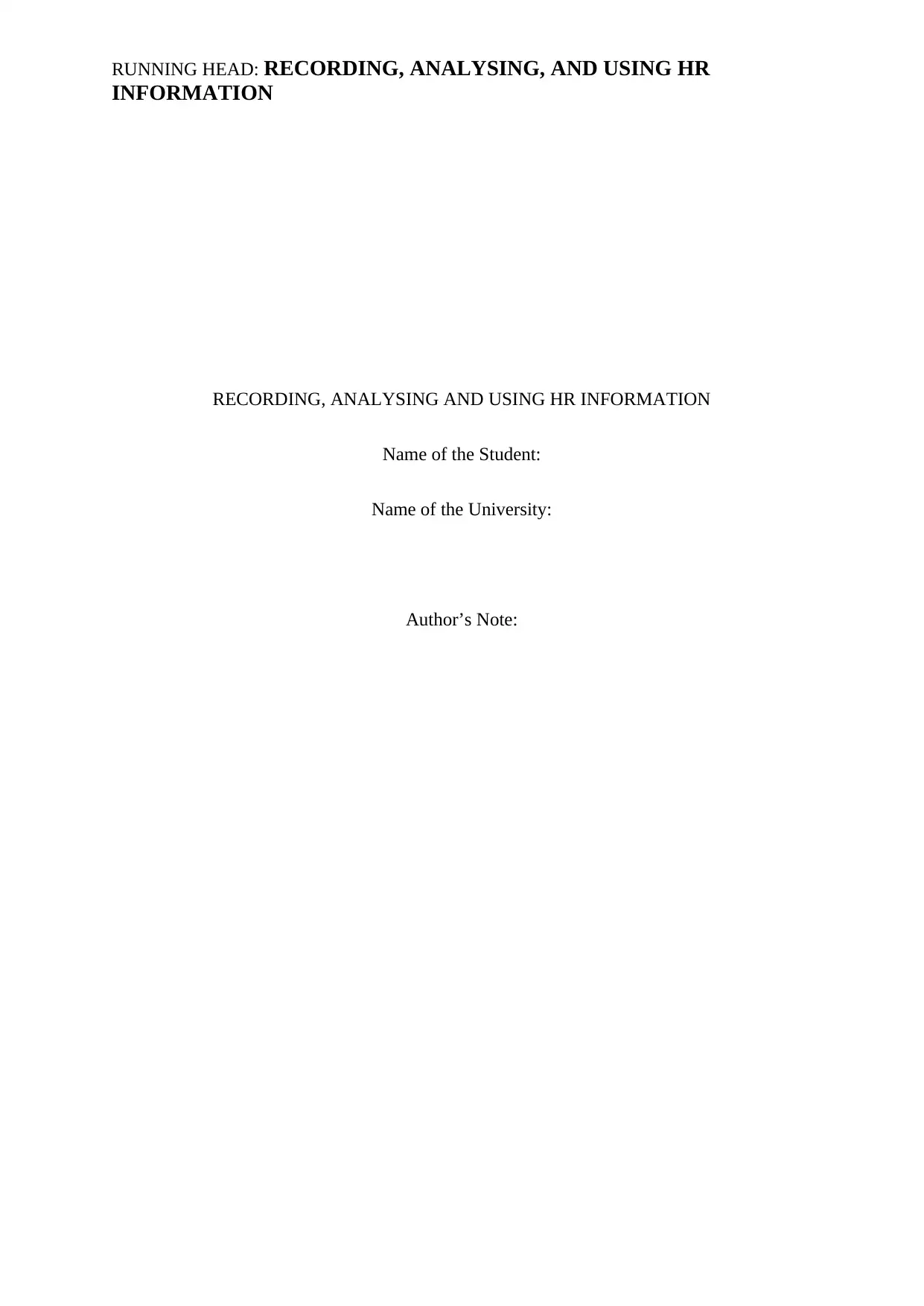
RUNNING HEAD: RECORDING, ANALYSING, AND USING HR
INFORMATION
RECORDING, ANALYSING AND USING HR INFORMATION
Name of the Student:
Name of the University:
Author’s Note:
INFORMATION
RECORDING, ANALYSING AND USING HR INFORMATION
Name of the Student:
Name of the University:
Author’s Note:
Paraphrase This Document
Need a fresh take? Get an instant paraphrase of this document with our AI Paraphraser
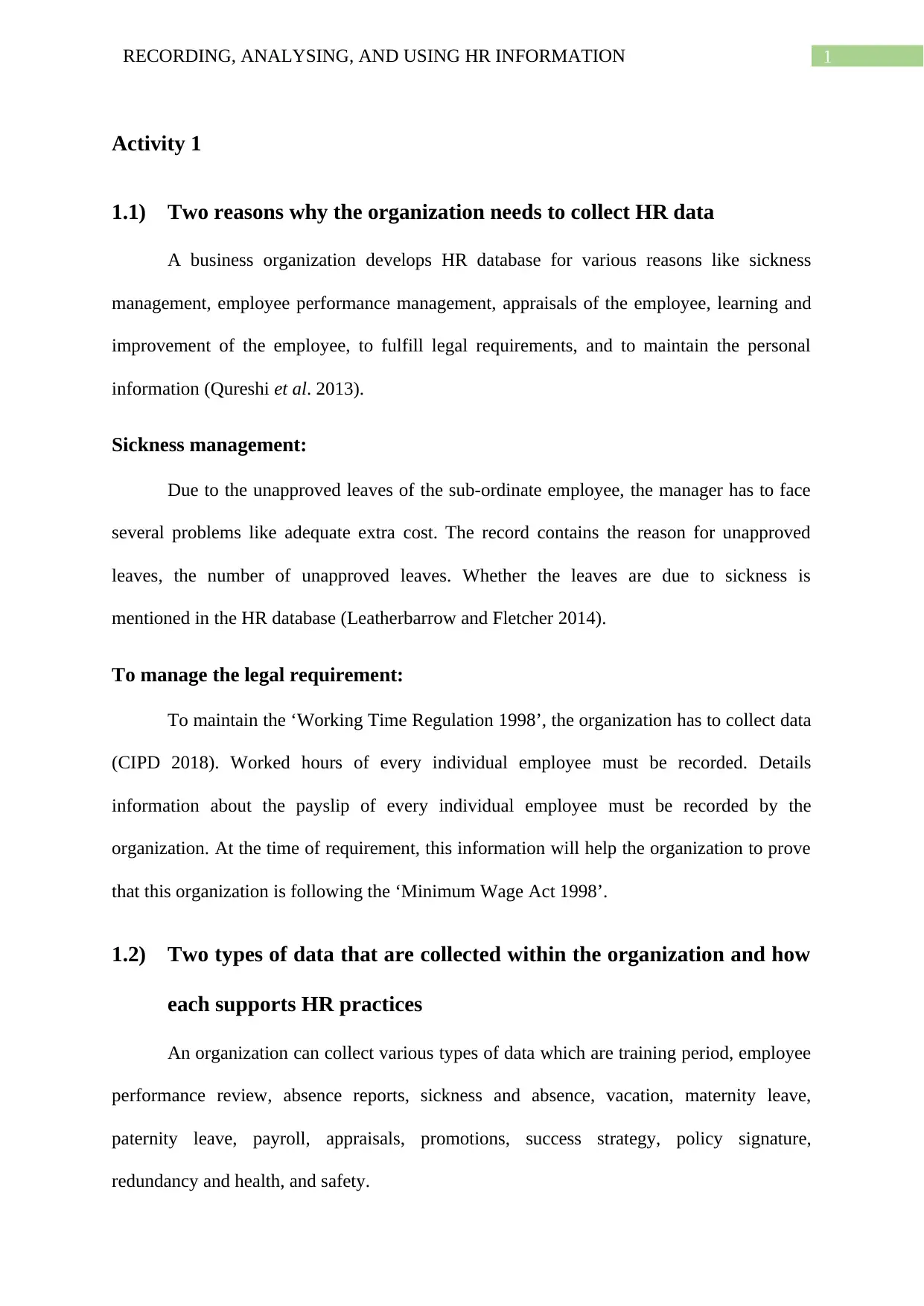
1RECORDING, ANALYSING, AND USING HR INFORMATION
Activity 1
1.1) Two reasons why the organization needs to collect HR data
A business organization develops HR database for various reasons like sickness
management, employee performance management, appraisals of the employee, learning and
improvement of the employee, to fulfill legal requirements, and to maintain the personal
information (Qureshi et al. 2013).
Sickness management:
Due to the unapproved leaves of the sub-ordinate employee, the manager has to face
several problems like adequate extra cost. The record contains the reason for unapproved
leaves, the number of unapproved leaves. Whether the leaves are due to sickness is
mentioned in the HR database (Leatherbarrow and Fletcher 2014).
To manage the legal requirement:
To maintain the ‘Working Time Regulation 1998’, the organization has to collect data
(CIPD 2018). Worked hours of every individual employee must be recorded. Details
information about the payslip of every individual employee must be recorded by the
organization. At the time of requirement, this information will help the organization to prove
that this organization is following the ‘Minimum Wage Act 1998’.
1.2) Two types of data that are collected within the organization and how
each supports HR practices
An organization can collect various types of data which are training period, employee
performance review, absence reports, sickness and absence, vacation, maternity leave,
paternity leave, payroll, appraisals, promotions, success strategy, policy signature,
redundancy and health, and safety.
Activity 1
1.1) Two reasons why the organization needs to collect HR data
A business organization develops HR database for various reasons like sickness
management, employee performance management, appraisals of the employee, learning and
improvement of the employee, to fulfill legal requirements, and to maintain the personal
information (Qureshi et al. 2013).
Sickness management:
Due to the unapproved leaves of the sub-ordinate employee, the manager has to face
several problems like adequate extra cost. The record contains the reason for unapproved
leaves, the number of unapproved leaves. Whether the leaves are due to sickness is
mentioned in the HR database (Leatherbarrow and Fletcher 2014).
To manage the legal requirement:
To maintain the ‘Working Time Regulation 1998’, the organization has to collect data
(CIPD 2018). Worked hours of every individual employee must be recorded. Details
information about the payslip of every individual employee must be recorded by the
organization. At the time of requirement, this information will help the organization to prove
that this organization is following the ‘Minimum Wage Act 1998’.
1.2) Two types of data that are collected within the organization and how
each supports HR practices
An organization can collect various types of data which are training period, employee
performance review, absence reports, sickness and absence, vacation, maternity leave,
paternity leave, payroll, appraisals, promotions, success strategy, policy signature,
redundancy and health, and safety.
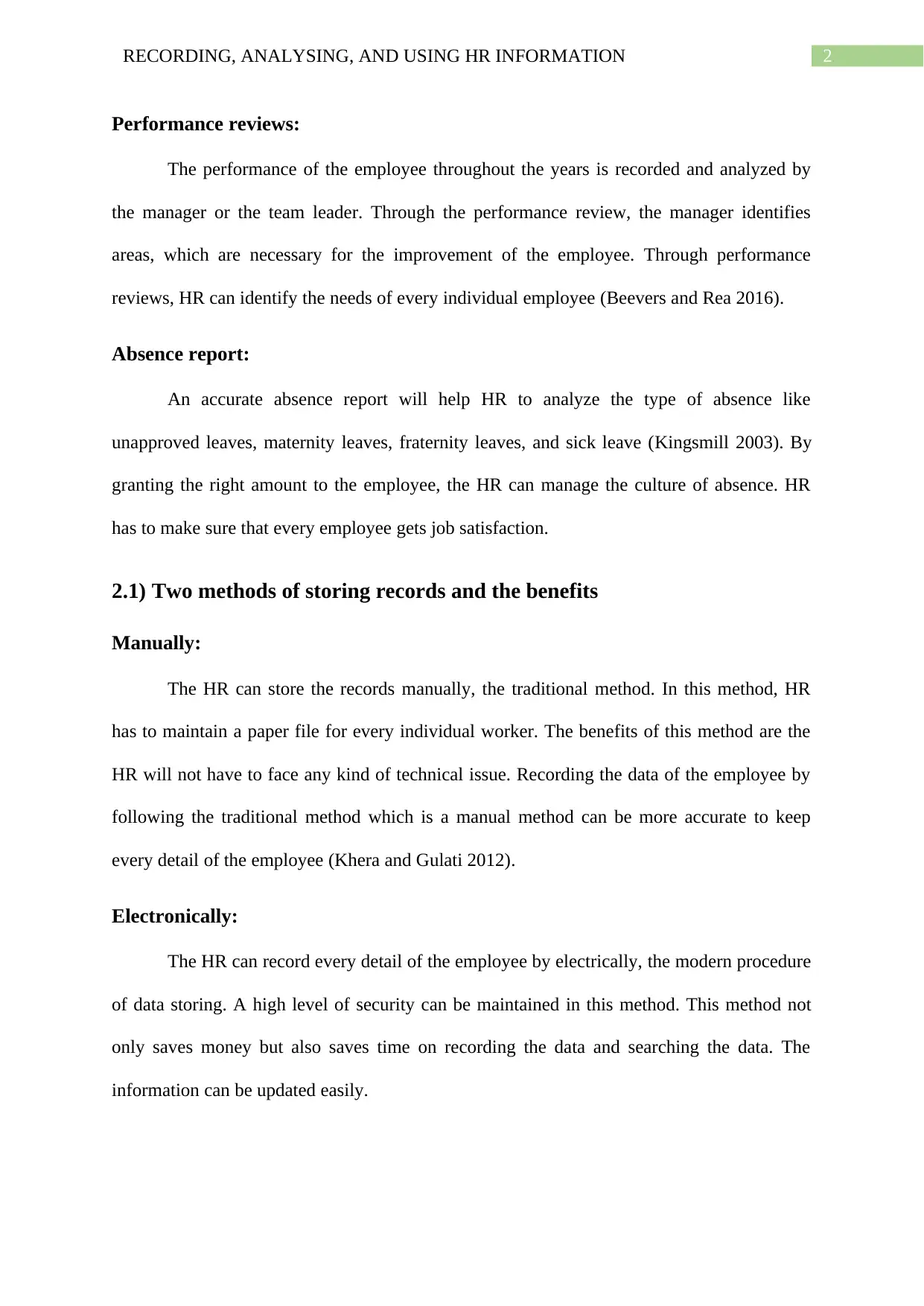
2RECORDING, ANALYSING, AND USING HR INFORMATION
Performance reviews:
The performance of the employee throughout the years is recorded and analyzed by
the manager or the team leader. Through the performance review, the manager identifies
areas, which are necessary for the improvement of the employee. Through performance
reviews, HR can identify the needs of every individual employee (Beevers and Rea 2016).
Absence report:
An accurate absence report will help HR to analyze the type of absence like
unapproved leaves, maternity leaves, fraternity leaves, and sick leave (Kingsmill 2003). By
granting the right amount to the employee, the HR can manage the culture of absence. HR
has to make sure that every employee gets job satisfaction.
2.1) Two methods of storing records and the benefits
Manually:
The HR can store the records manually, the traditional method. In this method, HR
has to maintain a paper file for every individual worker. The benefits of this method are the
HR will not have to face any kind of technical issue. Recording the data of the employee by
following the traditional method which is a manual method can be more accurate to keep
every detail of the employee (Khera and Gulati 2012).
Electronically:
The HR can record every detail of the employee by electrically, the modern procedure
of data storing. A high level of security can be maintained in this method. This method not
only saves money but also saves time on recording the data and searching the data. The
information can be updated easily.
Performance reviews:
The performance of the employee throughout the years is recorded and analyzed by
the manager or the team leader. Through the performance review, the manager identifies
areas, which are necessary for the improvement of the employee. Through performance
reviews, HR can identify the needs of every individual employee (Beevers and Rea 2016).
Absence report:
An accurate absence report will help HR to analyze the type of absence like
unapproved leaves, maternity leaves, fraternity leaves, and sick leave (Kingsmill 2003). By
granting the right amount to the employee, the HR can manage the culture of absence. HR
has to make sure that every employee gets job satisfaction.
2.1) Two methods of storing records and the benefits
Manually:
The HR can store the records manually, the traditional method. In this method, HR
has to maintain a paper file for every individual worker. The benefits of this method are the
HR will not have to face any kind of technical issue. Recording the data of the employee by
following the traditional method which is a manual method can be more accurate to keep
every detail of the employee (Khera and Gulati 2012).
Electronically:
The HR can record every detail of the employee by electrically, the modern procedure
of data storing. A high level of security can be maintained in this method. This method not
only saves money but also saves time on recording the data and searching the data. The
information can be updated easily.
⊘ This is a preview!⊘
Do you want full access?
Subscribe today to unlock all pages.

Trusted by 1+ million students worldwide
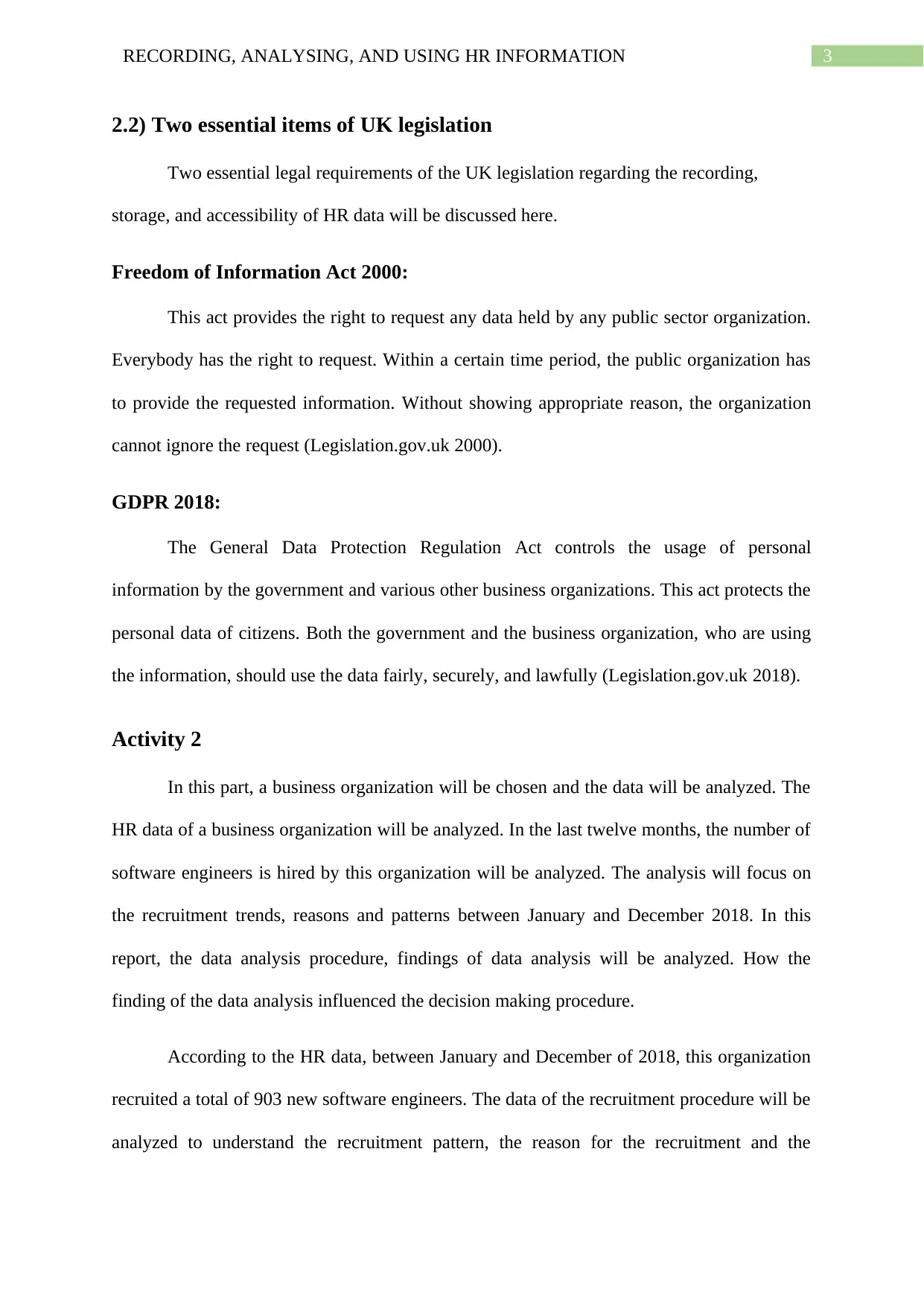
3RECORDING, ANALYSING, AND USING HR INFORMATION
2.2) Two essential items of UK legislation
Two essential legal requirements of the UK legislation regarding the recording,
storage, and accessibility of HR data will be discussed here.
Freedom of Information Act 2000:
This act provides the right to request any data held by any public sector organization.
Everybody has the right to request. Within a certain time period, the public organization has
to provide the requested information. Without showing appropriate reason, the organization
cannot ignore the request (Legislation.gov.uk 2000).
GDPR 2018:
The General Data Protection Regulation Act controls the usage of personal
information by the government and various other business organizations. This act protects the
personal data of citizens. Both the government and the business organization, who are using
the information, should use the data fairly, securely, and lawfully (Legislation.gov.uk 2018).
Activity 2
In this part, a business organization will be chosen and the data will be analyzed. The
HR data of a business organization will be analyzed. In the last twelve months, the number of
software engineers is hired by this organization will be analyzed. The analysis will focus on
the recruitment trends, reasons and patterns between January and December 2018. In this
report, the data analysis procedure, findings of data analysis will be analyzed. How the
finding of the data analysis influenced the decision making procedure.
According to the HR data, between January and December of 2018, this organization
recruited a total of 903 new software engineers. The data of the recruitment procedure will be
analyzed to understand the recruitment pattern, the reason for the recruitment and the
2.2) Two essential items of UK legislation
Two essential legal requirements of the UK legislation regarding the recording,
storage, and accessibility of HR data will be discussed here.
Freedom of Information Act 2000:
This act provides the right to request any data held by any public sector organization.
Everybody has the right to request. Within a certain time period, the public organization has
to provide the requested information. Without showing appropriate reason, the organization
cannot ignore the request (Legislation.gov.uk 2000).
GDPR 2018:
The General Data Protection Regulation Act controls the usage of personal
information by the government and various other business organizations. This act protects the
personal data of citizens. Both the government and the business organization, who are using
the information, should use the data fairly, securely, and lawfully (Legislation.gov.uk 2018).
Activity 2
In this part, a business organization will be chosen and the data will be analyzed. The
HR data of a business organization will be analyzed. In the last twelve months, the number of
software engineers is hired by this organization will be analyzed. The analysis will focus on
the recruitment trends, reasons and patterns between January and December 2018. In this
report, the data analysis procedure, findings of data analysis will be analyzed. How the
finding of the data analysis influenced the decision making procedure.
According to the HR data, between January and December of 2018, this organization
recruited a total of 903 new software engineers. The data of the recruitment procedure will be
analyzed to understand the recruitment pattern, the reason for the recruitment and the
Paraphrase This Document
Need a fresh take? Get an instant paraphrase of this document with our AI Paraphraser
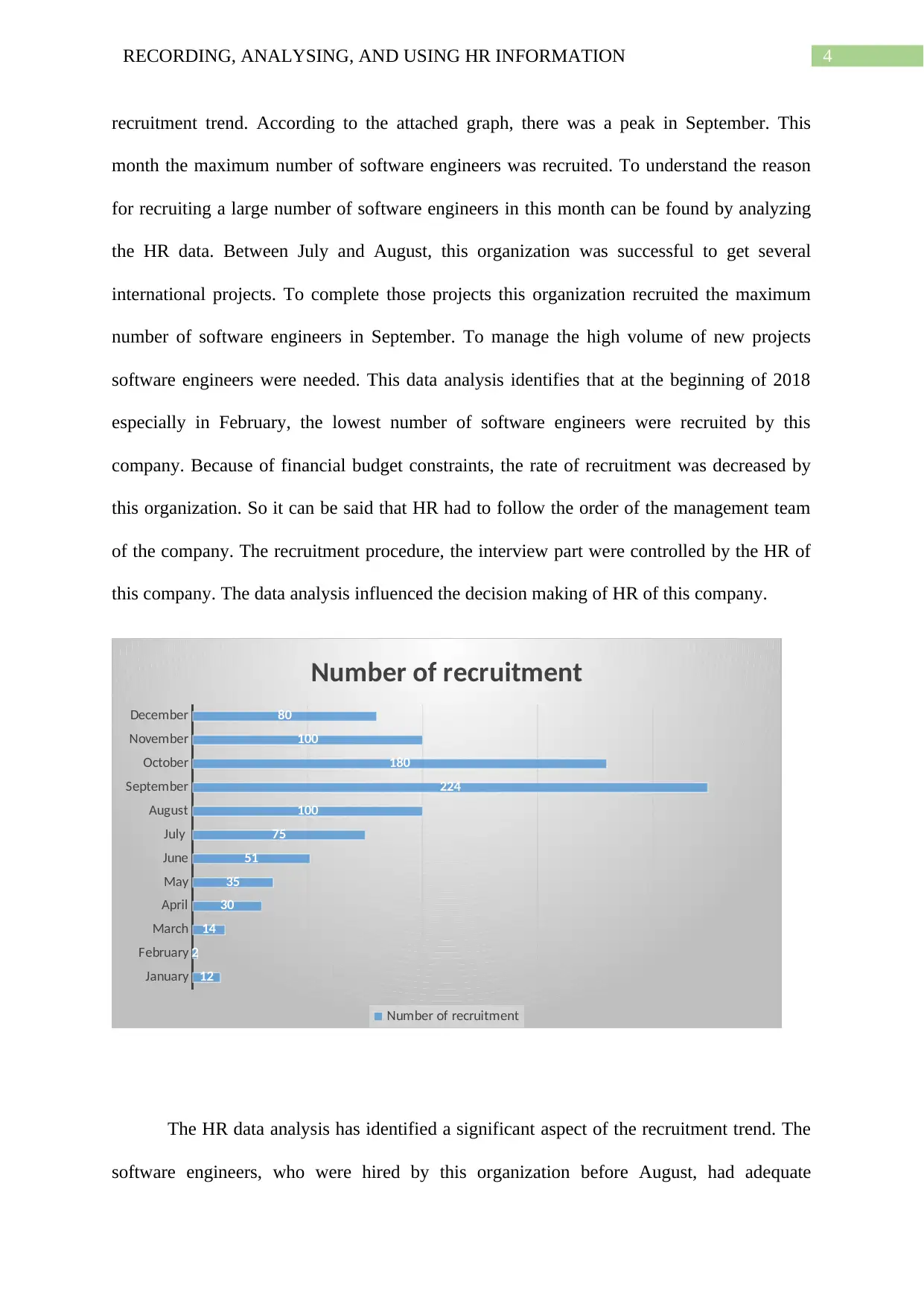
4RECORDING, ANALYSING, AND USING HR INFORMATION
recruitment trend. According to the attached graph, there was a peak in September. This
month the maximum number of software engineers was recruited. To understand the reason
for recruiting a large number of software engineers in this month can be found by analyzing
the HR data. Between July and August, this organization was successful to get several
international projects. To complete those projects this organization recruited the maximum
number of software engineers in September. To manage the high volume of new projects
software engineers were needed. This data analysis identifies that at the beginning of 2018
especially in February, the lowest number of software engineers were recruited by this
company. Because of financial budget constraints, the rate of recruitment was decreased by
this organization. So it can be said that HR had to follow the order of the management team
of the company. The recruitment procedure, the interview part were controlled by the HR of
this company. The data analysis influenced the decision making of HR of this company.
January
February
March
April
May
June
July
August
September
October
November
December
12
2
14
30
35
51
75
100
224
180
100
80
Number of recruitment
Number of recruitment
The HR data analysis has identified a significant aspect of the recruitment trend. The
software engineers, who were hired by this organization before August, had adequate
recruitment trend. According to the attached graph, there was a peak in September. This
month the maximum number of software engineers was recruited. To understand the reason
for recruiting a large number of software engineers in this month can be found by analyzing
the HR data. Between July and August, this organization was successful to get several
international projects. To complete those projects this organization recruited the maximum
number of software engineers in September. To manage the high volume of new projects
software engineers were needed. This data analysis identifies that at the beginning of 2018
especially in February, the lowest number of software engineers were recruited by this
company. Because of financial budget constraints, the rate of recruitment was decreased by
this organization. So it can be said that HR had to follow the order of the management team
of the company. The recruitment procedure, the interview part were controlled by the HR of
this company. The data analysis influenced the decision making of HR of this company.
January
February
March
April
May
June
July
August
September
October
November
December
12
2
14
30
35
51
75
100
224
180
100
80
Number of recruitment
Number of recruitment
The HR data analysis has identified a significant aspect of the recruitment trend. The
software engineers, who were hired by this organization before August, had adequate
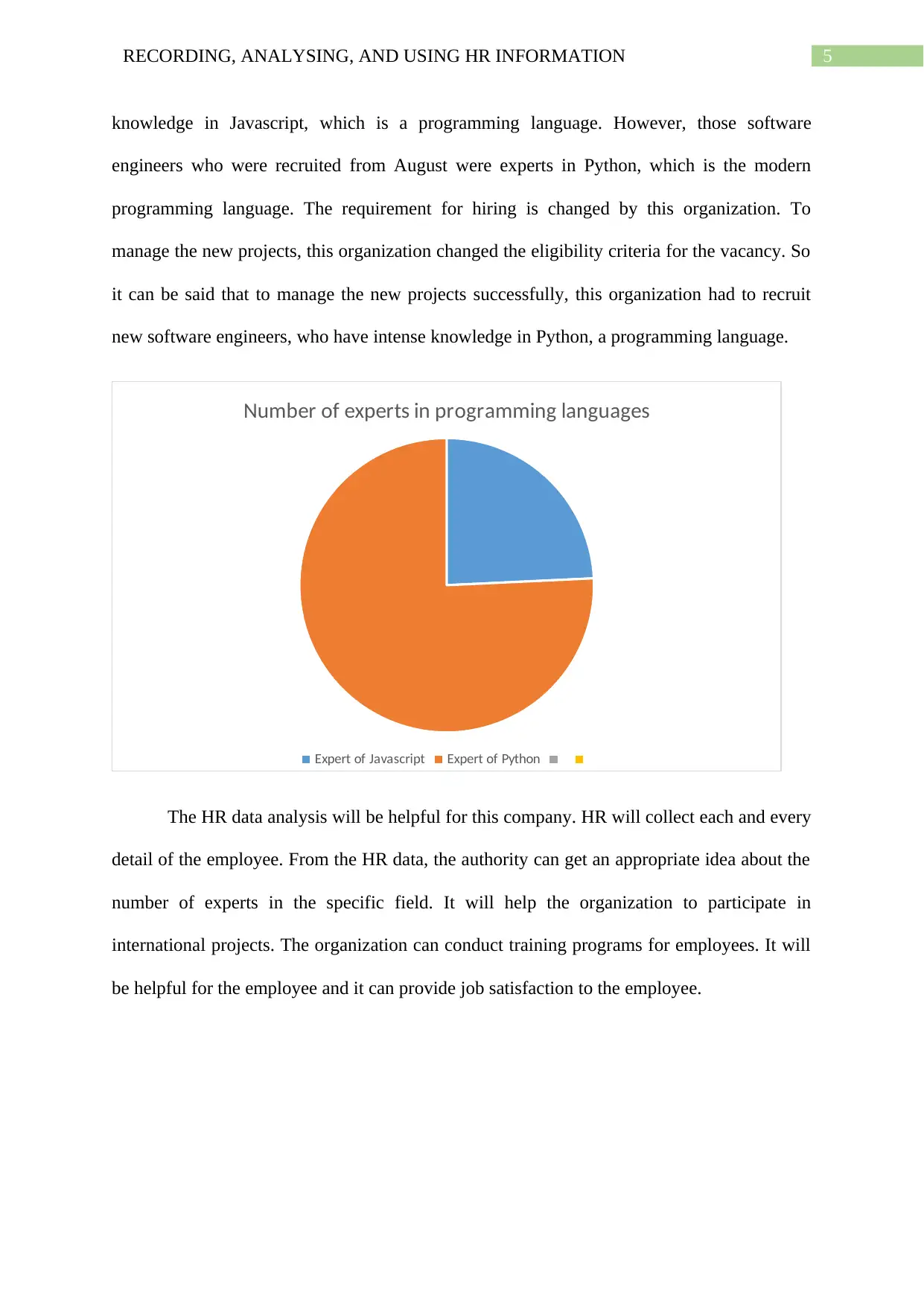
5RECORDING, ANALYSING, AND USING HR INFORMATION
knowledge in Javascript, which is a programming language. However, those software
engineers who were recruited from August were experts in Python, which is the modern
programming language. The requirement for hiring is changed by this organization. To
manage the new projects, this organization changed the eligibility criteria for the vacancy. So
it can be said that to manage the new projects successfully, this organization had to recruit
new software engineers, who have intense knowledge in Python, a programming language.
Number of experts in programming languages
Expert of Javascript Expert of Python
The HR data analysis will be helpful for this company. HR will collect each and every
detail of the employee. From the HR data, the authority can get an appropriate idea about the
number of experts in the specific field. It will help the organization to participate in
international projects. The organization can conduct training programs for employees. It will
be helpful for the employee and it can provide job satisfaction to the employee.
knowledge in Javascript, which is a programming language. However, those software
engineers who were recruited from August were experts in Python, which is the modern
programming language. The requirement for hiring is changed by this organization. To
manage the new projects, this organization changed the eligibility criteria for the vacancy. So
it can be said that to manage the new projects successfully, this organization had to recruit
new software engineers, who have intense knowledge in Python, a programming language.
Number of experts in programming languages
Expert of Javascript Expert of Python
The HR data analysis will be helpful for this company. HR will collect each and every
detail of the employee. From the HR data, the authority can get an appropriate idea about the
number of experts in the specific field. It will help the organization to participate in
international projects. The organization can conduct training programs for employees. It will
be helpful for the employee and it can provide job satisfaction to the employee.
⊘ This is a preview!⊘
Do you want full access?
Subscribe today to unlock all pages.

Trusted by 1+ million students worldwide
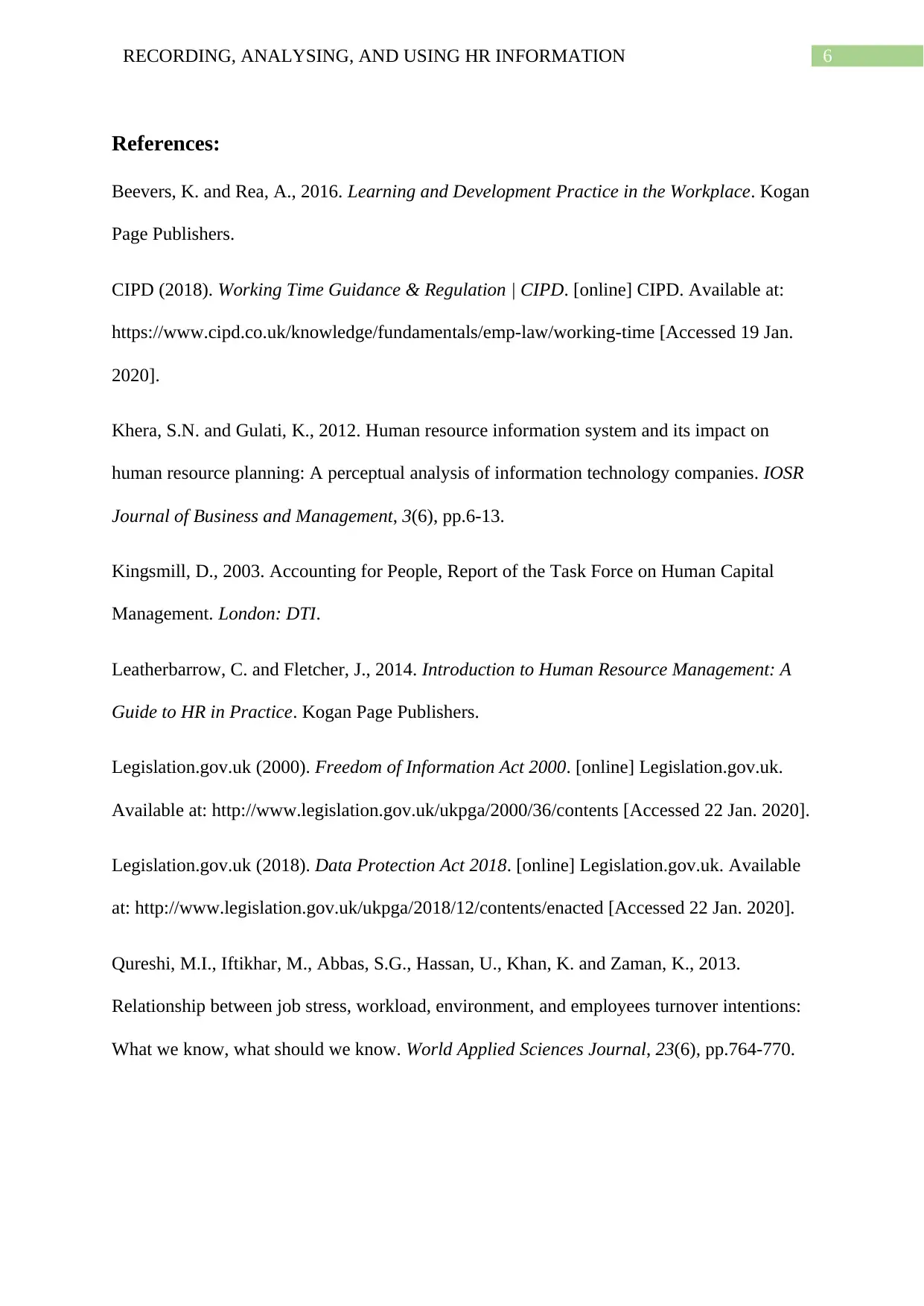
6RECORDING, ANALYSING, AND USING HR INFORMATION
References:
Beevers, K. and Rea, A., 2016. Learning and Development Practice in the Workplace. Kogan
Page Publishers.
CIPD (2018). Working Time Guidance & Regulation | CIPD. [online] CIPD. Available at:
https://www.cipd.co.uk/knowledge/fundamentals/emp-law/working-time [Accessed 19 Jan.
2020].
Khera, S.N. and Gulati, K., 2012. Human resource information system and its impact on
human resource planning: A perceptual analysis of information technology companies. IOSR
Journal of Business and Management, 3(6), pp.6-13.
Kingsmill, D., 2003. Accounting for People, Report of the Task Force on Human Capital
Management. London: DTI.
Leatherbarrow, C. and Fletcher, J., 2014. Introduction to Human Resource Management: A
Guide to HR in Practice. Kogan Page Publishers.
Legislation.gov.uk (2000). Freedom of Information Act 2000. [online] Legislation.gov.uk.
Available at: http://www.legislation.gov.uk/ukpga/2000/36/contents [Accessed 22 Jan. 2020].
Legislation.gov.uk (2018). Data Protection Act 2018. [online] Legislation.gov.uk. Available
at: http://www.legislation.gov.uk/ukpga/2018/12/contents/enacted [Accessed 22 Jan. 2020].
Qureshi, M.I., Iftikhar, M., Abbas, S.G., Hassan, U., Khan, K. and Zaman, K., 2013.
Relationship between job stress, workload, environment, and employees turnover intentions:
What we know, what should we know. World Applied Sciences Journal, 23(6), pp.764-770.
References:
Beevers, K. and Rea, A., 2016. Learning and Development Practice in the Workplace. Kogan
Page Publishers.
CIPD (2018). Working Time Guidance & Regulation | CIPD. [online] CIPD. Available at:
https://www.cipd.co.uk/knowledge/fundamentals/emp-law/working-time [Accessed 19 Jan.
2020].
Khera, S.N. and Gulati, K., 2012. Human resource information system and its impact on
human resource planning: A perceptual analysis of information technology companies. IOSR
Journal of Business and Management, 3(6), pp.6-13.
Kingsmill, D., 2003. Accounting for People, Report of the Task Force on Human Capital
Management. London: DTI.
Leatherbarrow, C. and Fletcher, J., 2014. Introduction to Human Resource Management: A
Guide to HR in Practice. Kogan Page Publishers.
Legislation.gov.uk (2000). Freedom of Information Act 2000. [online] Legislation.gov.uk.
Available at: http://www.legislation.gov.uk/ukpga/2000/36/contents [Accessed 22 Jan. 2020].
Legislation.gov.uk (2018). Data Protection Act 2018. [online] Legislation.gov.uk. Available
at: http://www.legislation.gov.uk/ukpga/2018/12/contents/enacted [Accessed 22 Jan. 2020].
Qureshi, M.I., Iftikhar, M., Abbas, S.G., Hassan, U., Khan, K. and Zaman, K., 2013.
Relationship between job stress, workload, environment, and employees turnover intentions:
What we know, what should we know. World Applied Sciences Journal, 23(6), pp.764-770.
1 out of 7
Related Documents
Your All-in-One AI-Powered Toolkit for Academic Success.
+13062052269
info@desklib.com
Available 24*7 on WhatsApp / Email
![[object Object]](/_next/static/media/star-bottom.7253800d.svg)
Unlock your academic potential
Copyright © 2020–2025 A2Z Services. All Rights Reserved. Developed and managed by ZUCOL.




